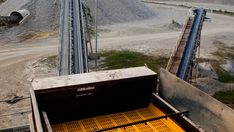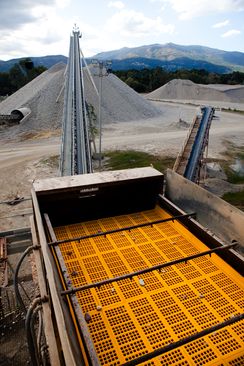Asia
EMEA

LANXESS Canada Contacts
Contact our Sites in Canada
Media Inquiries
General Inquiries
Please click here to e-mail LANXESS Canada with product inquiries and general requests.
Global Press Releases
2018-04-23
LANXESS launches a new prepolymer for polyurethane cast elastomers
Low compression set and yet high tear strength
- Post curing of parts can be delayed without degradation in mechanical properties
- High productivity and low energy consumption
- Key properties can be optimized for specific applications
Specialty chemicals company LANXESS has developed Vibrathane 7085, a new, polyester-based prepolymer for hot cast elastomers. It has MDI end groups (methylene diphenyl diisocyanate) and cures with 1,4-butanediol to polyurethane cast elastomers, distinguished by a low compression set and a high tear strength at hardnesses of 83 to 87 Shore A. “This is a particular advantage of our material. Both properties are usually inversely related, so that they normally can’t be optimized together,” explains Dr. Nitin Sharma, expert in the Global Research & Development and Innovation Center of the Urethane Systems business unit of LANXESS. The general purpose prepolymer can be economically processed under catalysis in short to medium pot lifes to produce elastomer solutions which cover a wide range of demands. “Possible applications include, for example, die cutting blankets and anvils, bushings for torque rods of trucks, buses and trailers, and robust, noise-damping shaking screens for ore processing,” as Sharma further reports.
Low fatigue tendency under cyclic loading
Depending on the processing conditions, Vibrathane 7085 produces cast elastomers with compression sets from 13 percent to 42 percent according to ASTM D395 (American Society for Testing and Materials), method B (70 °C, 22 h). Tear strength according to ASTM D1938 (Tear Strength, Trouser), for example, is between 27.2 and 85.9 kilonewton per meter. “Compared with standard polyurethane elastomers of similar hardness, the compression set is about 1.7 times lower and the tear strength up to three times higher,” says Sharma. In addition, the flexural fatigue strength is at a high level. For example, tests according to ASTM D3629-99 showed Texus Flex values of more than 170,000 cycles at deformations of 11, 18, 35 and 45 percent and a stoichiometry of 102 percent.
Higher productivity, lower energy consumption
By using the catalyst, the reaction of the prepolymer with the chain-extender speeds up. Therefore, the parts can be demolded faster and the tools can be refilled earlier. Sharma: “The processor can thus increase the throughput of parts, making his production more efficient.” In addition, optimized processing conditions help to shorten post curing duration. This results in lower energy consumption, which opens up cost savings and improves the sustainability of production. Pot life can be kept short at 90 seconds, but can also be extended to around 4.5 minutes, for example to achieve uniform tool filling for more complex component geometries. Moreover, the processor can delay the post curing of the demolded parts without degradation in tear strength, compression set or other mechanical properties of the final elastomer product. “Therefore, demolded parts can be collected first and then be post-cured together, increasing flexibility and manufacturing efficiency,” explains Sharma.
Compression set and tear strength can be individually optimized
Both the compression set and the tear strength can be separately optimized and thus adapted to specific demands of an application. For example, the tear strength can be increased to 85.9 kilonewton per meter, whereby this material variant still has a compression set of 42 percent. In contrast to this is an elastomer with a compression set of only 15 percent and excellent dynamic properties. Sharma: “This material is, therefore, particularly suitable for dynamically highly stressed components such as wheels and rolls of forklift trucks.”
Forward-Looking Statements
This company release contains certain forward-looking statements, including assumptions, opinions, expectations and views of the company or cited from third party sources. Various known and unknown risks, uncertainties and other factors could cause the actual results, financial position, development or performance of LANXESS AG to differ materially from the estimations expressed or implied herein. LANXESS AG does not guarantee that the assumptions underlying such forward-looking statements are free from errors nor does it accept any responsibility for the future accuracy of the opinions expressed in this presentation or the actual occurrence of the forecast developments. No representation or warranty (expressed or implied) is made as to, and no reliance should be placed on, any information, estimates, targets and opinions, contained herein, and no liability whatsoever is accepted as to any errors, omissions or misstatements contained herein, and accordingly, no representative of LANXESS AG or any of its affiliated companies or any of such person's officers, directors or employees accept any liability whatsoever arising directly or indirectly from the use of this document.
LANXESS is a leading specialty chemicals company with sales of EUR 9.7 billion in 2017 and about 19,200 employees in 25 countries. The company is currently represented at 74 production sites worldwide. The core business of LANXESS is the development, manufacturing and marketing of chemical intermediates, additives, specialty chemicals and plastics. Through ARLANXEO, the joint venture with Saudi Aramco, LANXESS is also a leading supplier of synthetic rubber. LANXESS is listed in the leading sustainability indices Dow Jones Sustainability Index (DJSI World and Europe) and FTSE4Good.
- Gallery






